Design and Modeling of a Fully Integrated Microring-Based Photonic Sensing System for Liquid Refractometry
Abstract
1. Introduction
2. PIC-Based Sensing System Concept and Operation Principle
2.1. Microring-Based Sensing System with a Broadband Optical Source
2.2. Matching the Frequency Characteristics of the Sensor, Interrogator, and Broadband Source
2.3. Microring-Based Sensing System with an Optoelectronic Oscillator
3. Sensing System Elements
3.1. Microring-Based Sensor
3.2. Microring-Based Interrogator
4. Sensing System Simulation
4.1. System Simulation with a Broadband Source
4.2. Simulating the System with Optoelectronic Oscillator as a Source
5. Bragg-Grating Interrogation Using an MRR-Based Interrogator
6. Discussion
7. Conclusions
Author Contributions
Funding
Institutional Review Board Statement
Informed Consent Statement
Data Availability Statement
Conflicts of Interest
References
- Luan, E.; Shoman, H.; Ratner, D.M.; Cheung, K.C.; Chrostowski, L. Silicon photonic biosensors using label-free detection. Sensors 2018, 18, 3519. [Google Scholar] [CrossRef] [PubMed]
- Ciminelli, C.; Dell’Olio, F.; Conteduca, D.; Armenise, M.N. Silicon photonic biosensors. IET Optoelectron. 2019, 13, 48–54. [Google Scholar] [CrossRef]
- Chandrasekar, R.; Lapin, Z.J.; Nichols, A.S.; Braun, R.M.; Fountain, A.W. Photonic integrated circuits for department of defense-relevant chemical and biological sensing applications: State-of-the-art and future outlooks. Opt. Eng. 2019, 58, 1. [Google Scholar] [CrossRef]
- Morais, E.; Pontes, M.J.; Marques, C.; Leal-Junior, A. Liquid level sensor with two FBGs embedded in a PDMS diaphragm: Analysis of the linearity and sensitivity. Sensors 2022, 22, 1268. [Google Scholar] [CrossRef] [PubMed]
- Yang, D.; Liu, Y.; Wang, Y.; Zhang, T.; Shao, M.; Yu, D.; Fu, H.; Jia, Z. Integrated optic-fiber sensor based on enclosed EFPI and structural phase-shift for discriminating measurement of temperature, pressure and RI. Opt. Laser Technol. 2020, 126, 106112. [Google Scholar] [CrossRef]
- Li, H.; An, Z.; Mao, Q.; Zuo, S.; Zhu, W.; Zhang, S.; Zhang, C.; Li, E.; García, J.D.P. SOI waveguide bragg grating photonic sensor for human body temperature measurement based on photonic integrated interrogator. Nanomaterials 2021, 12, 29. [Google Scholar] [CrossRef] [PubMed]
- Liu, Y.; Liu, X.; Zhang, T.; Zhang, W. Integrated FPI-FBG composite all-fiber sensor for simultaneous measurement of liquid refractive index and temperature. Opt. Lasers Eng. 2018, 111, 167–171. [Google Scholar] [CrossRef]
- Vogelbacher, F.; Kothe, T.; Muellner, P.; Melnik, E.; Sagmeister, M.; Kraft, J.; Hainberger, R. Waveguide Mach-Zehnder biosensor with laser diode pumped integrated single-mode silicon nitride organic hybrid solid-state laser. Biosens. Bioelectron. 2022, 197, 113816. [Google Scholar] [CrossRef]
- Sun, X.; Dai, D.; Thylén, L.; Wosinski, L. High-sensitivity liquid refractive-index sensor based on a Mach-Zehnder interferometer with a double-slot hybrid plasmonic waveguide. Opt. Express 2015, 23, 25688. [Google Scholar] [CrossRef]
- Crespi, A.; Gu, Y.; Ngamsom, B.; Hoekstra, H.J.W.M.; Dongre, C.; Pollnau, M.; Ramponi, R.; van den Vlekkert, H.H.; Watts, P.; Cerullo, G.; et al. Three-dimensional Mach-Zehnder interferometer in a microfluidic chip for spatially-resolved label-free detection. Lab Chip 2010, 10, 1167. [Google Scholar] [CrossRef]
- Wu, S.; Guo, Y.; Wang, W.; Zhou, J.; Zhang, Q. Label-free biosensing using a microring resonator integrated with poly-(dimethylsiloxane) microfluidic channels. Rev. Sci. Instrum. 2019, 90, 035004. [Google Scholar] [CrossRef] [PubMed]
- Gangwar, R.K.; Qin, J.; Wang, X. Porous silicon–based microring resonator for temperature and cancer cell detection. Front. Phys. 2022, 10, 929033. [Google Scholar] [CrossRef]
- Bahadoran, M.; Seyfari, A.K.; Sanati, P.; Chua, L.S. Label free identification of the different status of anemia disease using optimized double-slot cascaded microring resonator. Sci. Rep. 2022, 12, 5548. [Google Scholar] [CrossRef]
- Sun, X.; Zeng, L.; Hu, Y.; Duan, J. Fabrication and sensing application of phase shifted bragg grating sensors. Materials 2022, 15, 3720. [Google Scholar] [CrossRef] [PubMed]
- Fernández Gavela, A.; Grajales García, D.; Ramirez, J.; Lechuga, L. Last advances in silicon-based optical biosensors. Sensors 2016, 16, 285. [Google Scholar] [CrossRef]
- Kazanskiy, N.L.; Khonina, S.N.; Butt, M.A. Advancement in silicon integrated photonics technologies for sensing applications in near-infrared and mid-infrared region: A review. Photonics 2022, 9, 331. [Google Scholar] [CrossRef]
- Cardenosa-Rubio, M.C.; Robison, H.M.; Bailey, R.C. Recent advances in environmental and clinical analysis using microring resonator-based sensors. Curr. Opin. Environ. Sci. Health 2019, 10, 38–46. [Google Scholar] [CrossRef] [PubMed]
- Zhang, P.; Ding, Y.; Wang, Y. Asymmetrical microring resonator based on whispering gallery modes for the detection of glucose concentration. Optik 2018, 171, 642–647. [Google Scholar] [CrossRef]
- Huang, W.; Luo, Y.; Zhang, W.; Li, C.; Li, L.; Yang, Z.; Xu, P. High-sensitivity refractive index sensor based on Ge–Sb–Se chalcogenide microring resonator. Infrared Phys. Technol. 2021, 116, 103792. [Google Scholar] [CrossRef]
- Bogaerts, W.; De Heyn, P.; Van Vaerenbergh, T.; De Vos, K.; Kumar Selvaraja, S.; Claes, T.; Dumon, P.; Bienstman, P.; Van Thourhout, D.; Baets, R. Silicon microring resonators. Laser Photonics Rev. 2012, 6, 47–73. [Google Scholar] [CrossRef]
- Huang, L.; Yan, H.; Xu, X.; Chakravarty, S.; Tang, N.; Tian, H.; Chen, R.T. Improving the detection limit for on-chip photonic sensors based on subwavelength grating racetrack resonators. Opt. Express 2017, 25, 10527. [Google Scholar] [CrossRef] [PubMed]
- Wu, N.; Xia, L. Side-mode suppressed filter based on anangular grating-subwavelength grating microring resonator with high flexibility in wavelength design. Appl. Opt. 2019, 58, 7174. [Google Scholar] [CrossRef] [PubMed]
- Zhao, C.Y.; Zhang, L.; Zhang, C.M. Compact SOI optimized slot microring coupled phase-shifted bragg grating resonator for sensing. Opt. Commun. 2018, 414, 212–216. [Google Scholar] [CrossRef]
- Słowikowski, M.; Kaźmierczak, A.; Stopiński, S.; Bieniek, M.; Szostak, S.; Matuk, K.; Augustin, L.; Piramidowicz, R. Photonic integrated interrogator for monitoring the patient condition during MRI diagnosis. Sensors 2021, 21, 4238. [Google Scholar] [CrossRef]
- Yao, J. Microwave photonic sensors. J. Light. Technol. 2021, 39, 3626–3637. [Google Scholar] [CrossRef]
- Tozzetti, L.; Bontempi, F.; Giacobbe, A.; Pasquale, F.D.; Faralli, S. Fast FBG interrogator on chip based on silicon on insulator ring resonator add/drop filters. J. Light. Technol. 2022, 40, 5328–5336. [Google Scholar] [CrossRef]
- Chew, S.X.; Yi, X.; Yang, W.; Wu, C.; Li, L.; Nguyen, L.; Minasian, R. Optoelectronic oscillator based sensor using an on-chip sensing probe. IEEE Photonics J. 2017, 9, 5500809. [Google Scholar] [CrossRef]
- Yao, J. Optoelectronic oscillators for high speed and high resolution optical sensing. J. Light. Technol. 2017, 35, 3489–3497. [Google Scholar] [CrossRef]
- Yao, J. Photonic generation of microwave arbitrary waveforms. Opt. Commun. 2011, 284, 3723–3736. [Google Scholar] [CrossRef]
- Marin, Y.E.; Nannipieri, T.; Oton, C.J.; Pasquale, F.D. Current status and future trends of photonic-integrated FBG interrogators. J. Light. Technol. 2018, 36, 946–953. [Google Scholar] [CrossRef]
- Shidlovski, V.R. Superluminescent diode light sources for OCT. In Optical Coherence Tomography; Biological and Medical Physics, Biomedical Engineering; Drexler, W., Fujimoto, J.G., Eds.; Springer: Berlin/Heidelberg, Germany, 2008; pp. 281–299. ISBN 978-3-540-77549-2. [Google Scholar]
- Rank, E.A.; Agneter, A.; Schmoll, T.; Leitgeb, R.A.; Drexler, W. Miniaturizing optical coherence tomography. Transl. Biophoton. 2022, 4, e202100007. [Google Scholar] [CrossRef]
- Yao, X.S.; Maleki, L. Optoelectronic microwave oscillator. J. Opt. Soc. Am. B 1996, 13, 1725. [Google Scholar] [CrossRef]
- Palik, E.D.; Ghosh, G. Handbook of Optical Constants of Solids; Academic Press: San Diego, CA, USA, 1998; ISBN 978-0-12-544415-6. [Google Scholar]
- Lu, Z.; Jhoja, J.; Klein, J.; Wang, X.; Liu, A.; Flueckiger, J.; Pond, J.; Chrostowski, L. Performance prediction for silicon photonics integrated circuits with layout-dependent correlated manufacturing variability. Opt. Express 2017, 25, 9712. [Google Scholar] [CrossRef]
- Chrostowski, L.; Hochberg, M. Silicon Photonics Design: From Devices to Systems, 1st ed.; Cambridge University Press: Cambridge, UK, 2015; ISBN 978-1-107-08545-9. [Google Scholar]
- Milvich, J.; Kohler, D.; Freude, W.; Koos, C. Integrated phase-sensitive photonic sensors: A system design tutorial. Adv. Opt. Photonics 2021, 13, 584. [Google Scholar] [CrossRef]
- Liow, T.Y.; Ang, K.W.; Fang, Q.; Song, J.F.; Xiong, Y.Z.; Yu, M.B.; Lo, G.-Q.; Kwong, D.L. Silicon modulators and germanium photodetectors on SOI: Monolithic integration, compatibility, and performance optimization. IEEE J. Sel. Top. Quantum Electron. 2010, 16, 307–315. [Google Scholar] [CrossRef]
- Zhang, W.; Yao, J. Silicon photonic integrated optoelectronic oscillator for frequency-tunable microwave generation. J. Light. Technol. 2018, 36, 4655–4663. [Google Scholar] [CrossRef]
- Venghaus, H.; Grote, N. (Eds.) Fibre Optic Communication: Key Devices, 2nd ed.; Springer Series in Optical Sciences; Springer: Berlin/Heidelberg, Germany; New York, NY, USA, 2017; ISBN 978-3-319-42365-4. [Google Scholar]
- Soref, R. Tutorial: Integrated-photonic switching structures. APL Photonics 2018, 3, 021101. [Google Scholar] [CrossRef]
- Hosseini, N.; Dekker, R.; Hoekman, M.; Dekkers, M.; Bos, J.; Leinse, A.; Heideman, R. Stress-optic modulator in TriPleX platform using a piezoelectric lead zirconate titanate (PZT) thin film. Opt. Express 2015, 23, 14018. [Google Scholar] [CrossRef]
- Augustin, L.M.; Santos, R.; den Haan, E.; Kleijn, S.; Thijs, P.J.A.; Latkowski, S.; Zhao, D.; Yao, W.; Bolk, J.; Ambrosius, H.; et al. InP-based generic foundry platform for photonic integrated circuits. IEEE J. Sel. Top. Quantum Electron. 2018, 24, 6100210. [Google Scholar] [CrossRef]
- Bowers, J.E.; Liu, A.Y. A comparison of four approaches to photonic integration. In Proceedings of the Optical Fiber Communication Conference, OSA. Los Angeles, CA, USA, 19–23 March 2017; p. 16930096. [Google Scholar]
- Jiao, Y.; Nishiyama, N.; van der Tol, J.; van Engelen, J.; Pogoretskiy, V.; Reniers, S.; Kashi, A.A.; Wang, Y.; Calzadilla, V.D.; Spiegelberg, M.; et al. InP membrane integrated photonics research. Semicond. Sci. Technol. 2020, 36, 013001. [Google Scholar] [CrossRef]
- Theurer, M.; Moehrle, M.; Sigmund, A.; Velthaus, K.-O.; Oldenbeuving, R.M.; Wevers, L.; Postma, F.M.; Mateman, R.; Schreuder, F.; Geskus, D.; et al. Flip-chip integration of InP to SiN photonic integrated circuits. J. Light. Technol. 2020, 38, 2630–2636. [Google Scholar] [CrossRef]
- Hu, Y.; Liang, D.; Beausoleil, R.G. An advanced III-V-on-silicon photonic integration platform. Opto-Electron. Adv. 2021, 4, 200094. [Google Scholar] [CrossRef]
- Yan, Z.; Han, Y.; Lin, L.; Xue, Y.; Ma, C.; Ng, W.K.; Wong, K.S.; Lau, K.M. A monolithic InP/SOI platform for integrated photonics. Light Sci. Appl. 2021, 10, 200. [Google Scholar] [CrossRef]
- Besancon, C.; Fanneau, P.; Neel, D.; Cerulo, G.; Vaissiere, N.; Make, D.; Pommereau, F.; Fournel, F.; Dupre, C.; Baron, T.; et al. Laser array covering 155 Nm wide spectral band achieved by selective area growth on silicon wafer. In Proceedings of the 2020 European Conference on Optical Communications (ECOC), IEEE. Brussels, Belgium, 6–10 December 2020; pp. 1–4. [Google Scholar]
- Xing, Y.; Dong, J.; Khan, U.; Bogaerts, W. Capturing the effects of spatial process variations in silicon photonic circuits. ACS Photonics 2022. [Google Scholar] [CrossRef]
- Siew, S.Y.; Li, B.; Gao, F.; Zheng, H.Y.; Zhang, W.; Guo, P.; Xie, S.W.; Song, A.; Dong, B.; Luo, L.W.; et al. Review of silicon photonics technology and platform development. J. Light. Technol. 2021, 39, 4374–4389. [Google Scholar] [CrossRef]
- Bogaerts, W.; Xing, Y.; Khan, U. Layout-aware variability analysis, yield prediction, and optimization in photonic integrated circuits. IEEE J. Sel. Top. Quantum Electron. 2019, 25, 6100413. [Google Scholar] [CrossRef]
- Buryak, A.V.; Stepanov, D.Y. Correction of systematic errors in the fabrication of fiber bragg gratings. Opt. Lett. 2002, 27, 1099. [Google Scholar] [CrossRef]
- Miller, G.A.; Flockhart, G.M.H.; Cranch, G.A. Technique for correcting systematic phase errors during fibre bragg grating inscription. Electron. Lett. 2008, 44, 1399. [Google Scholar] [CrossRef]
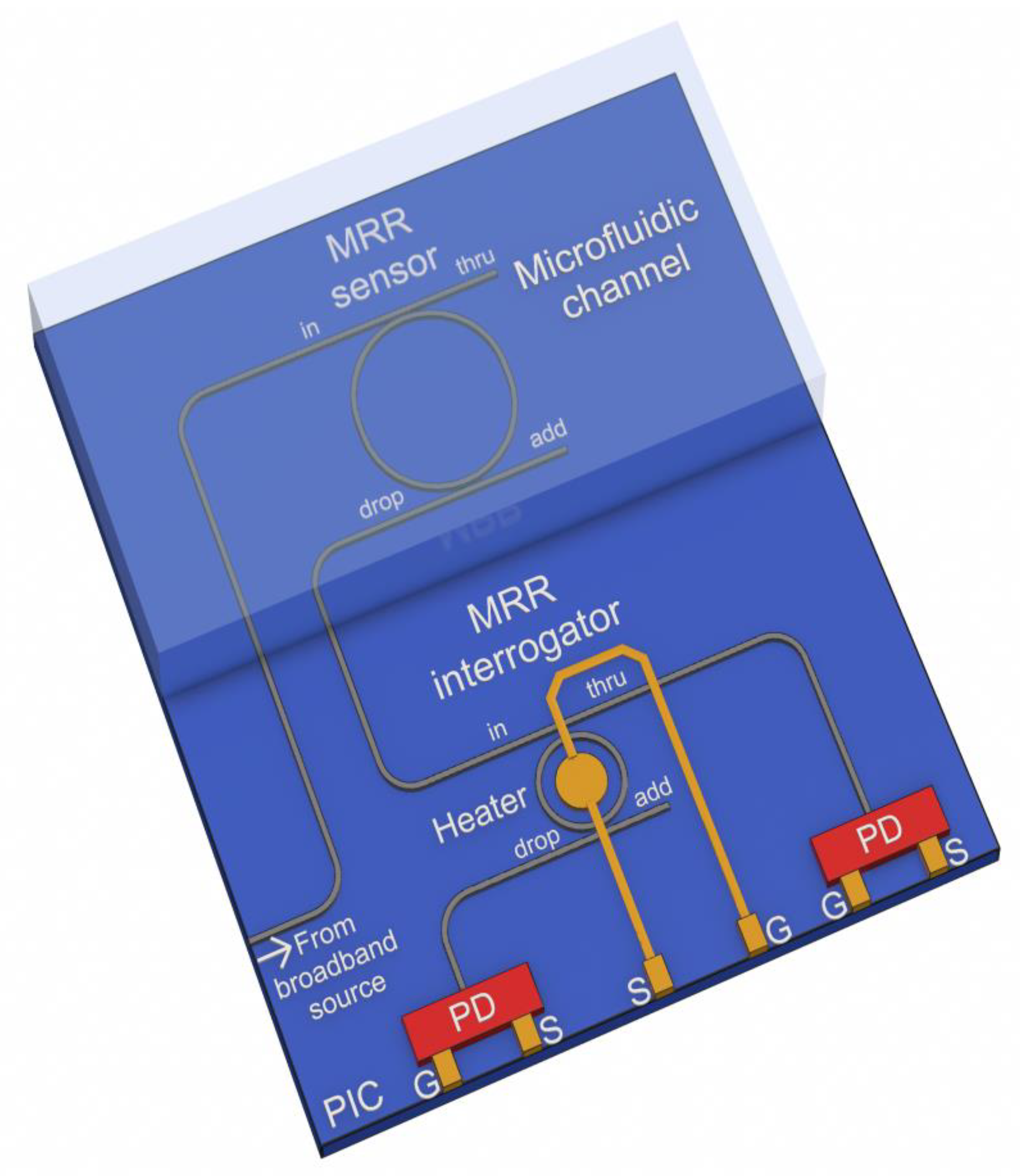

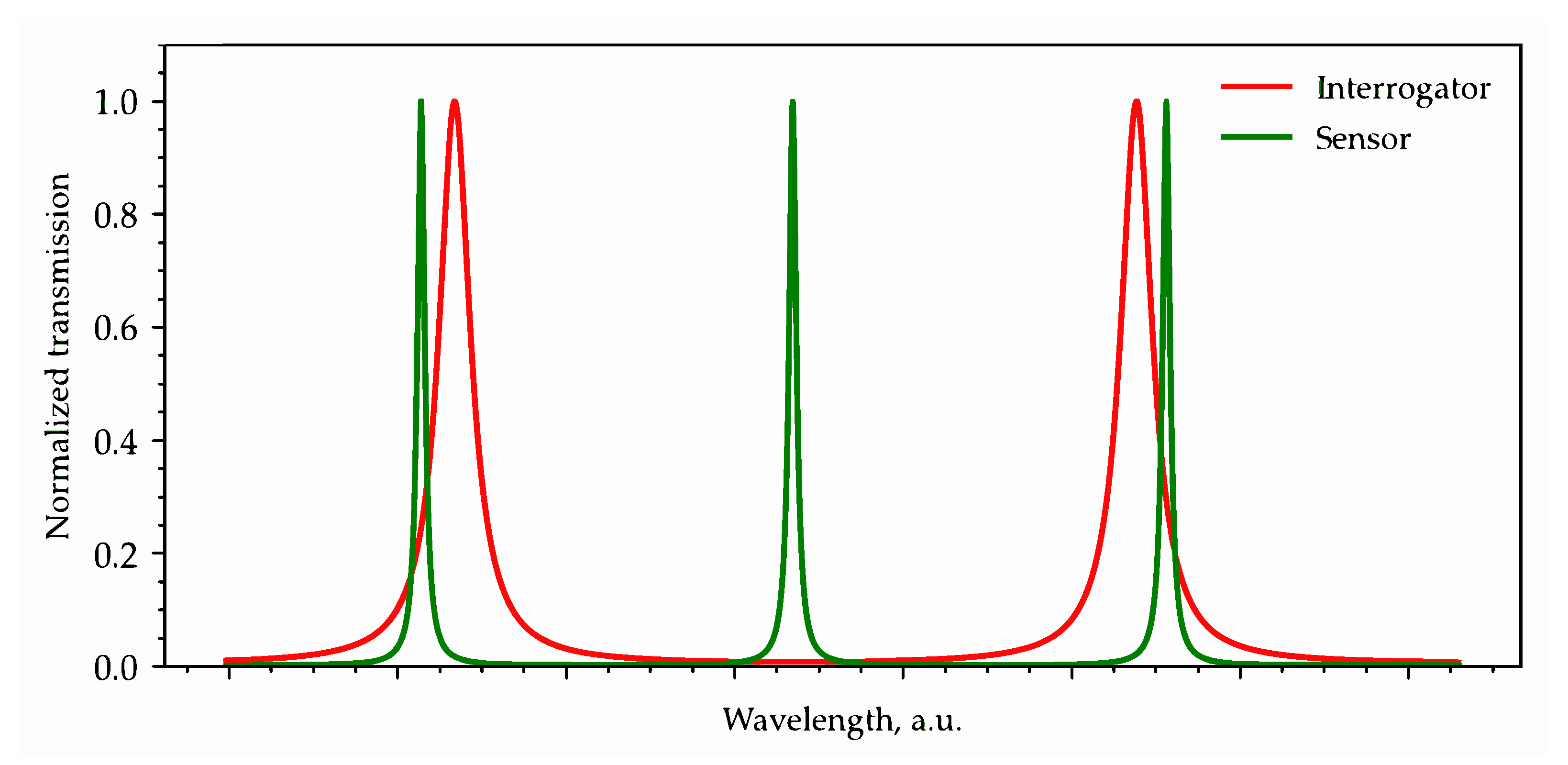

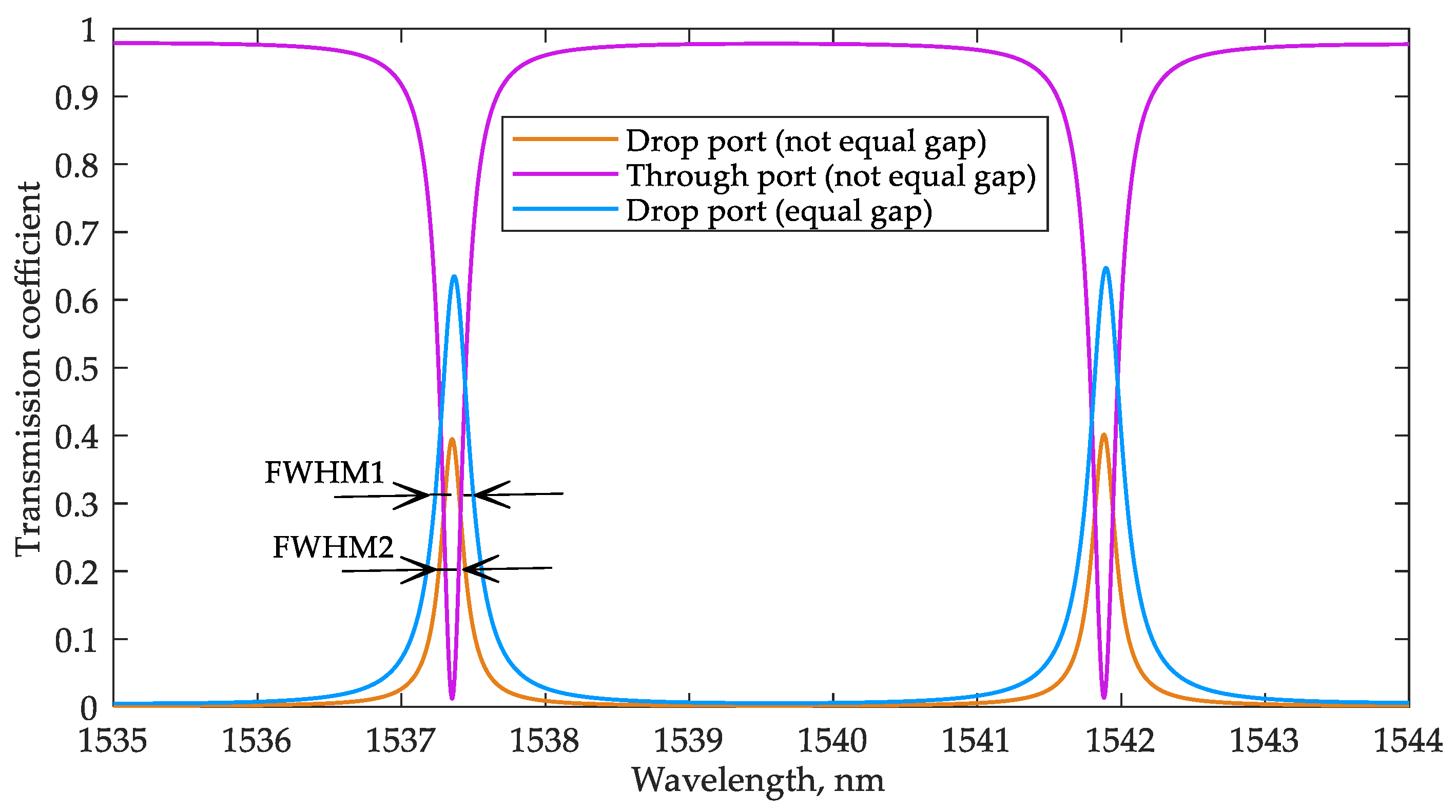
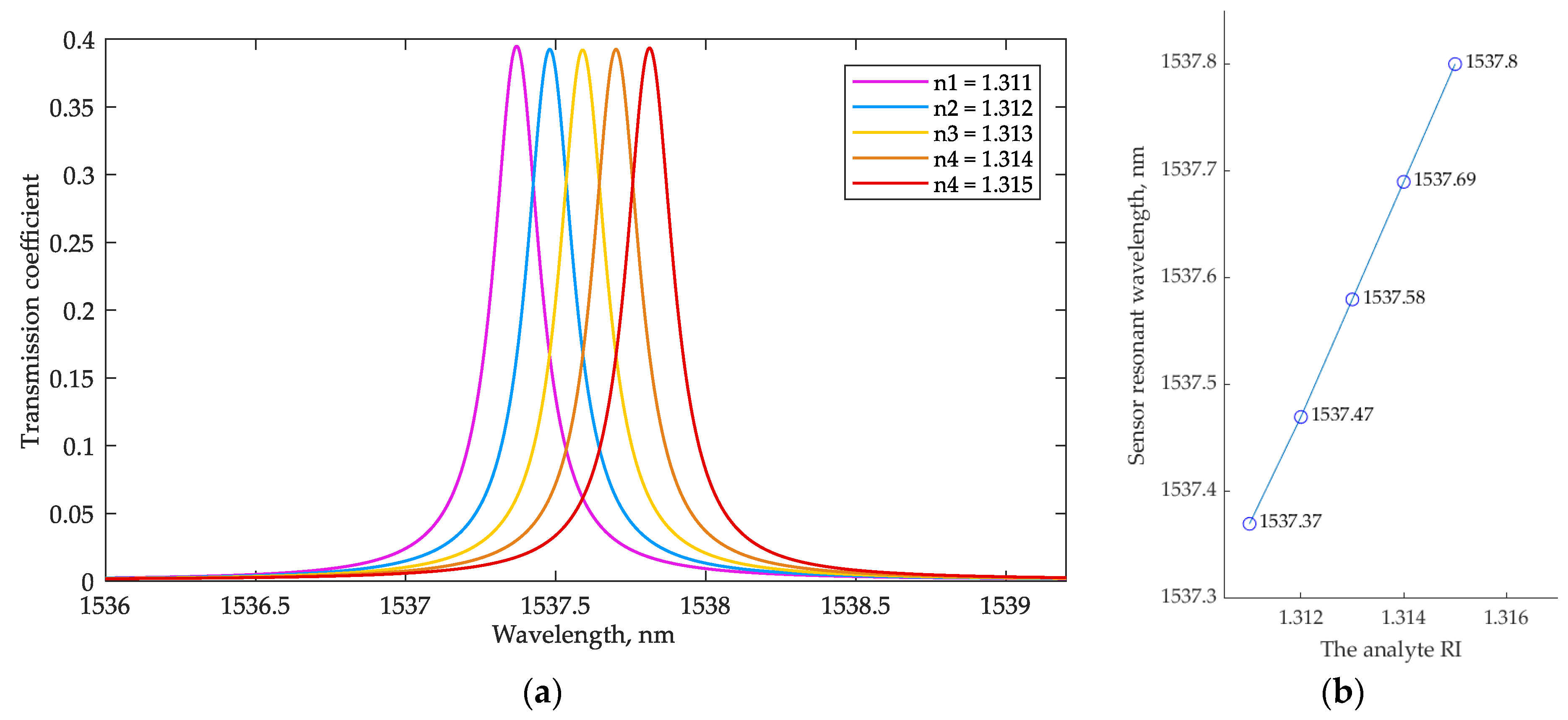
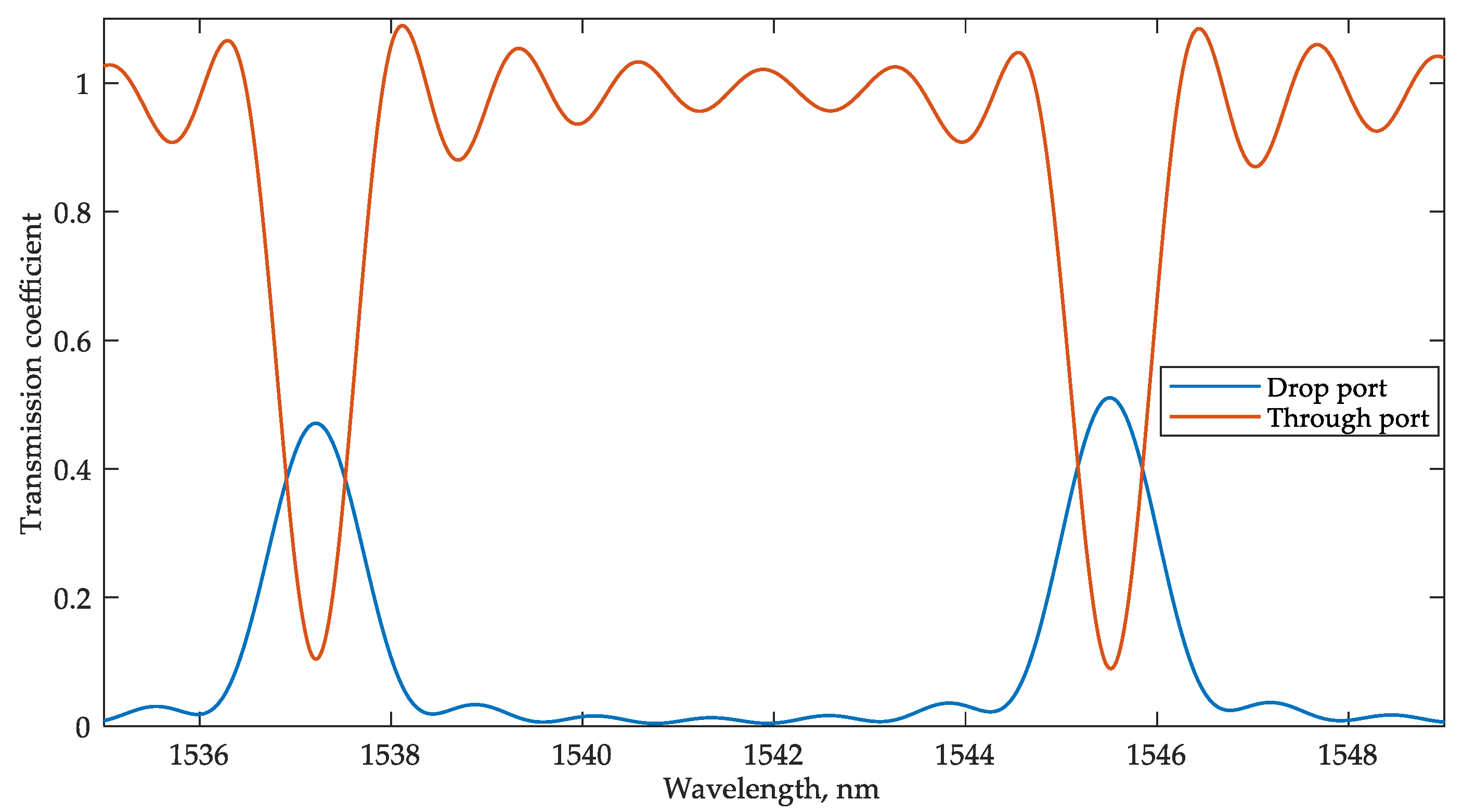


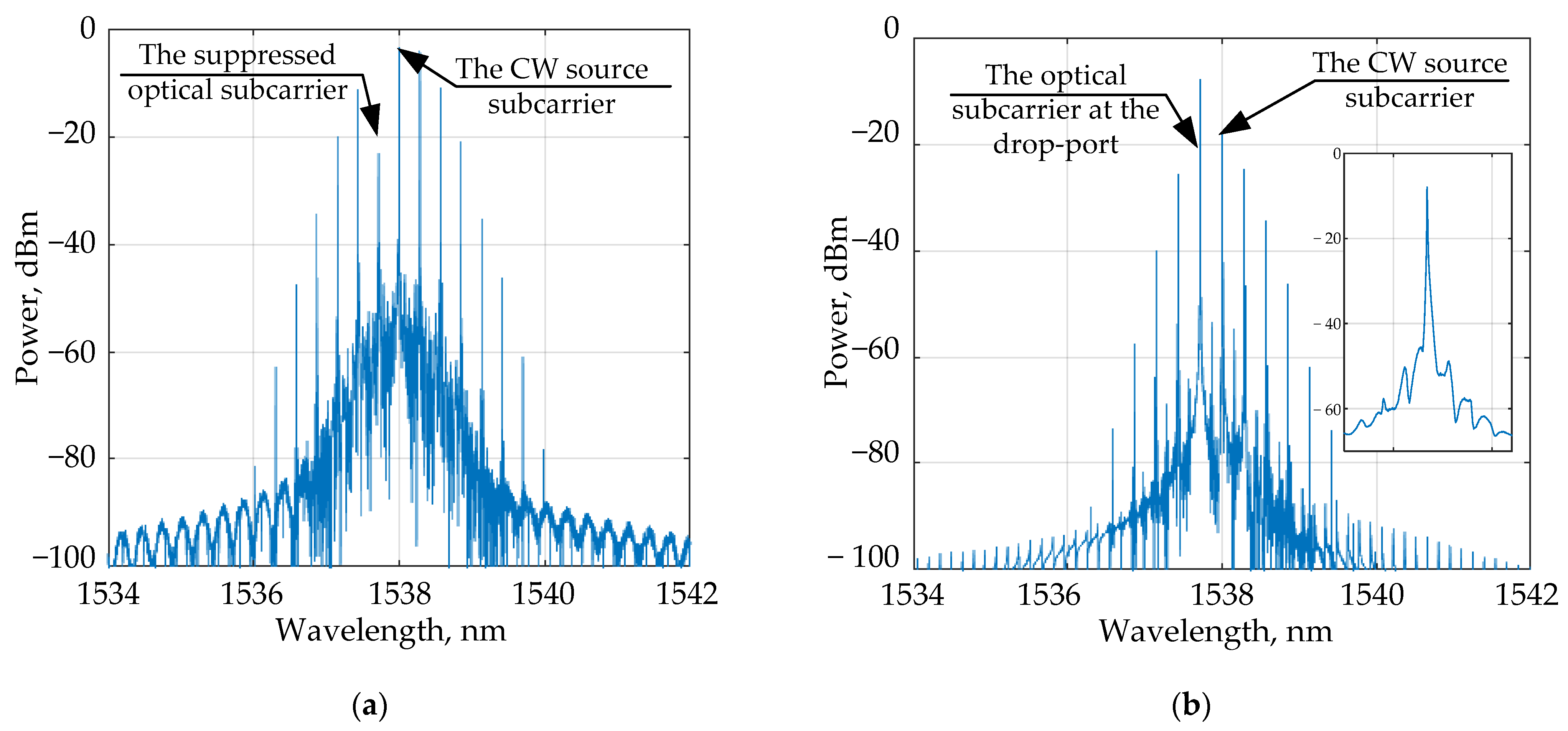


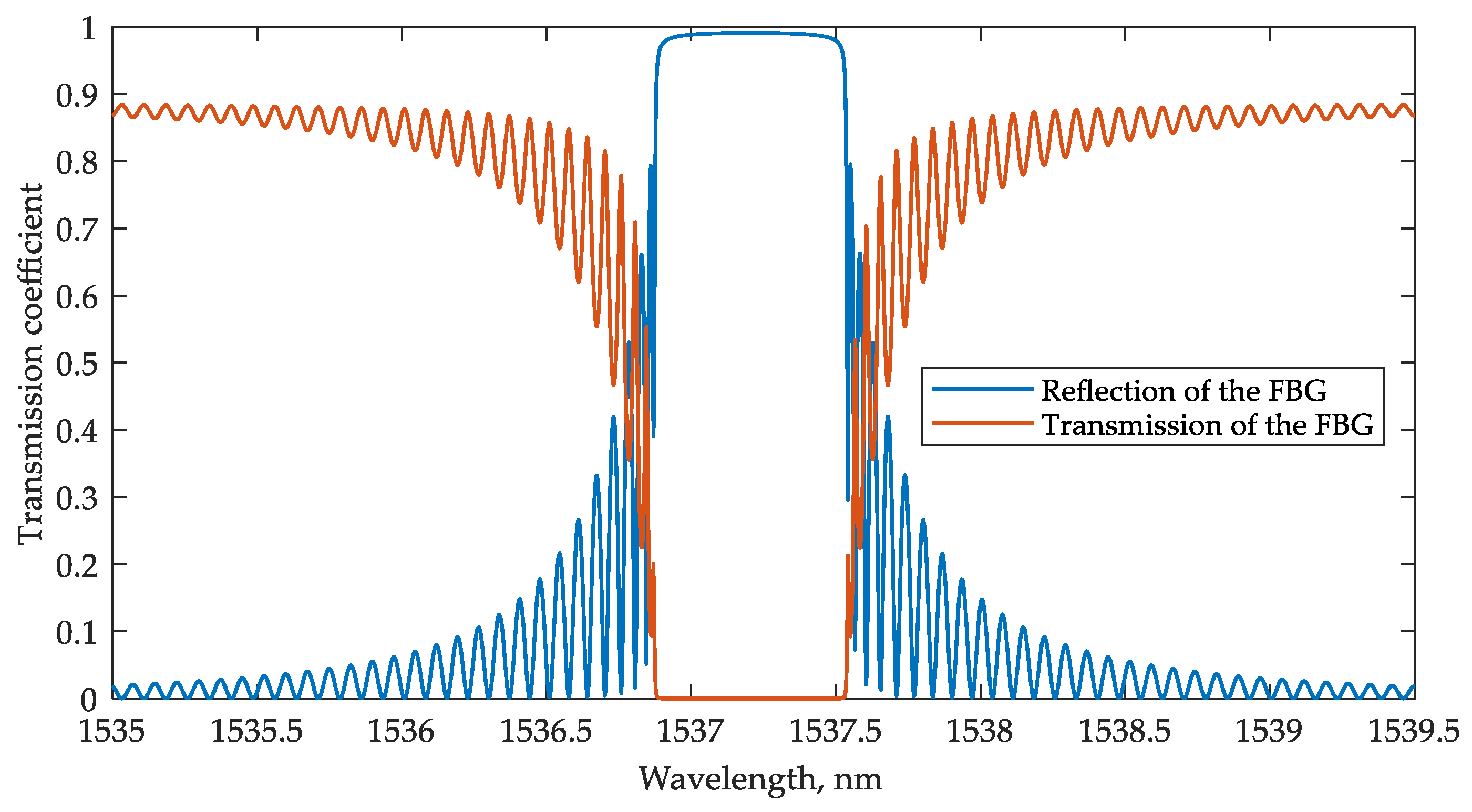
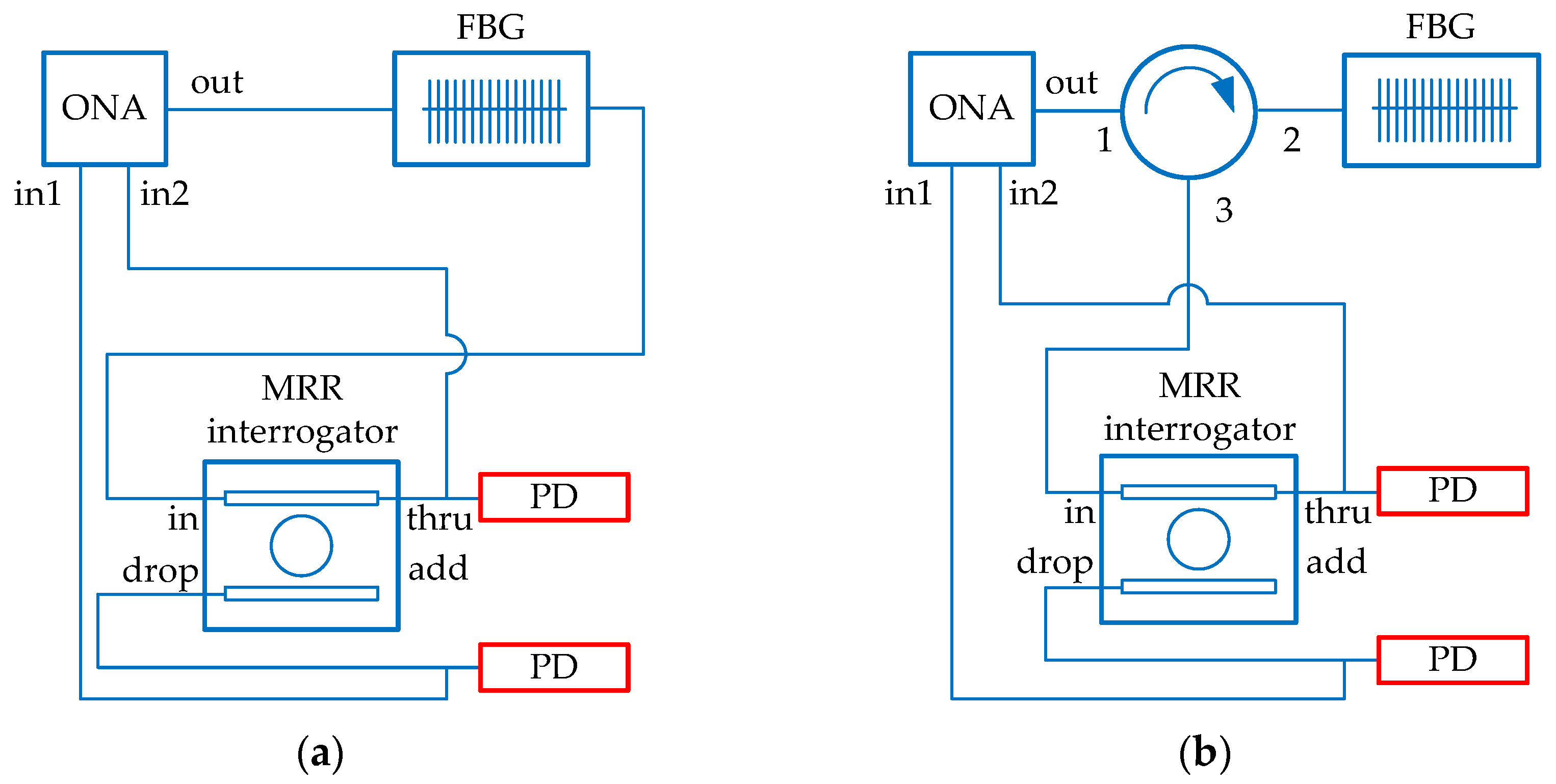

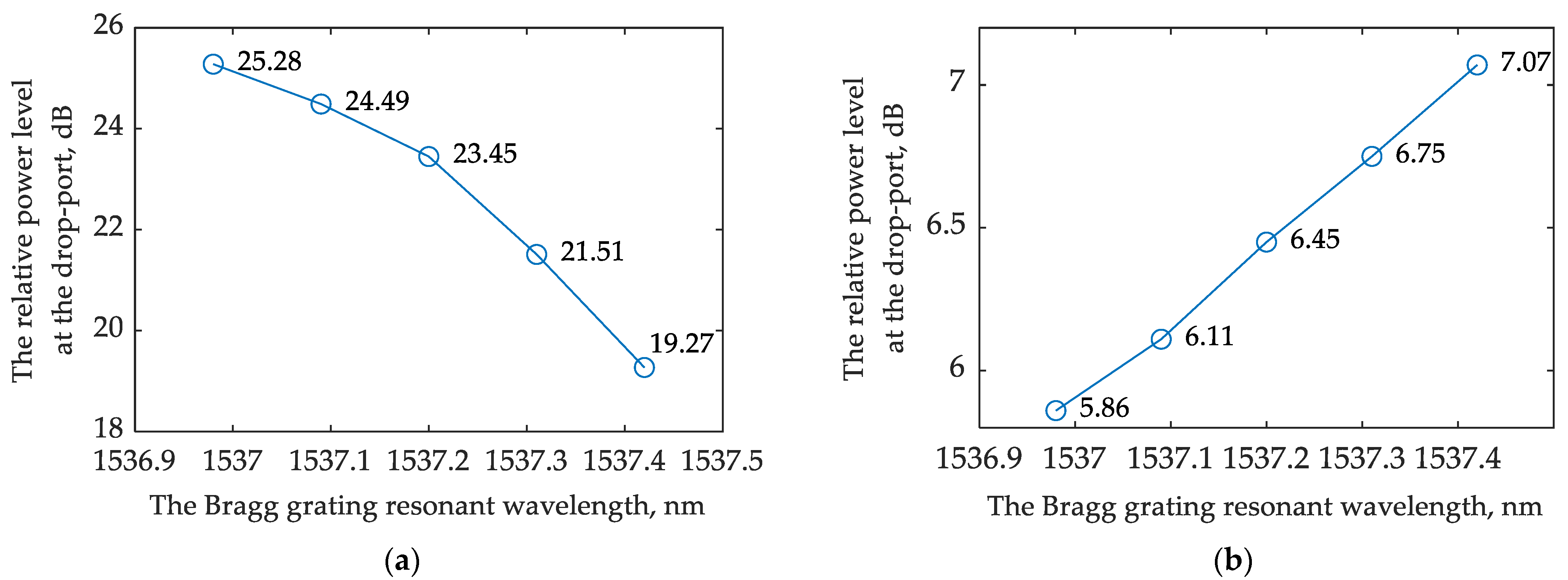



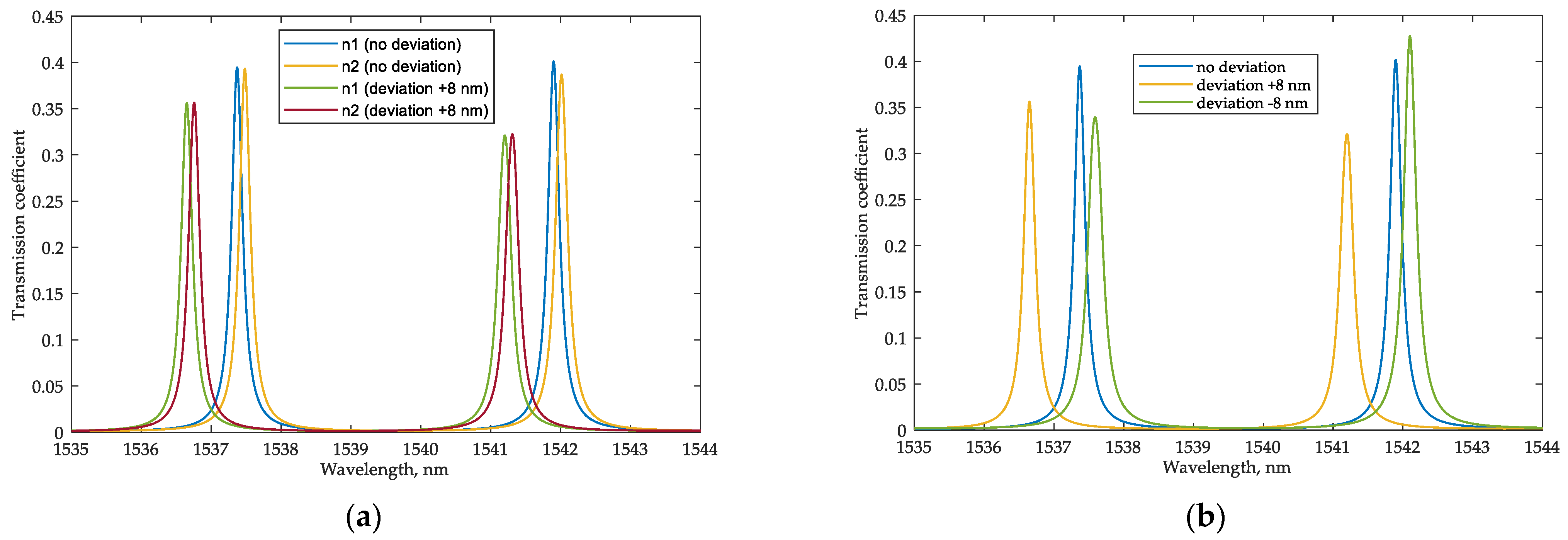
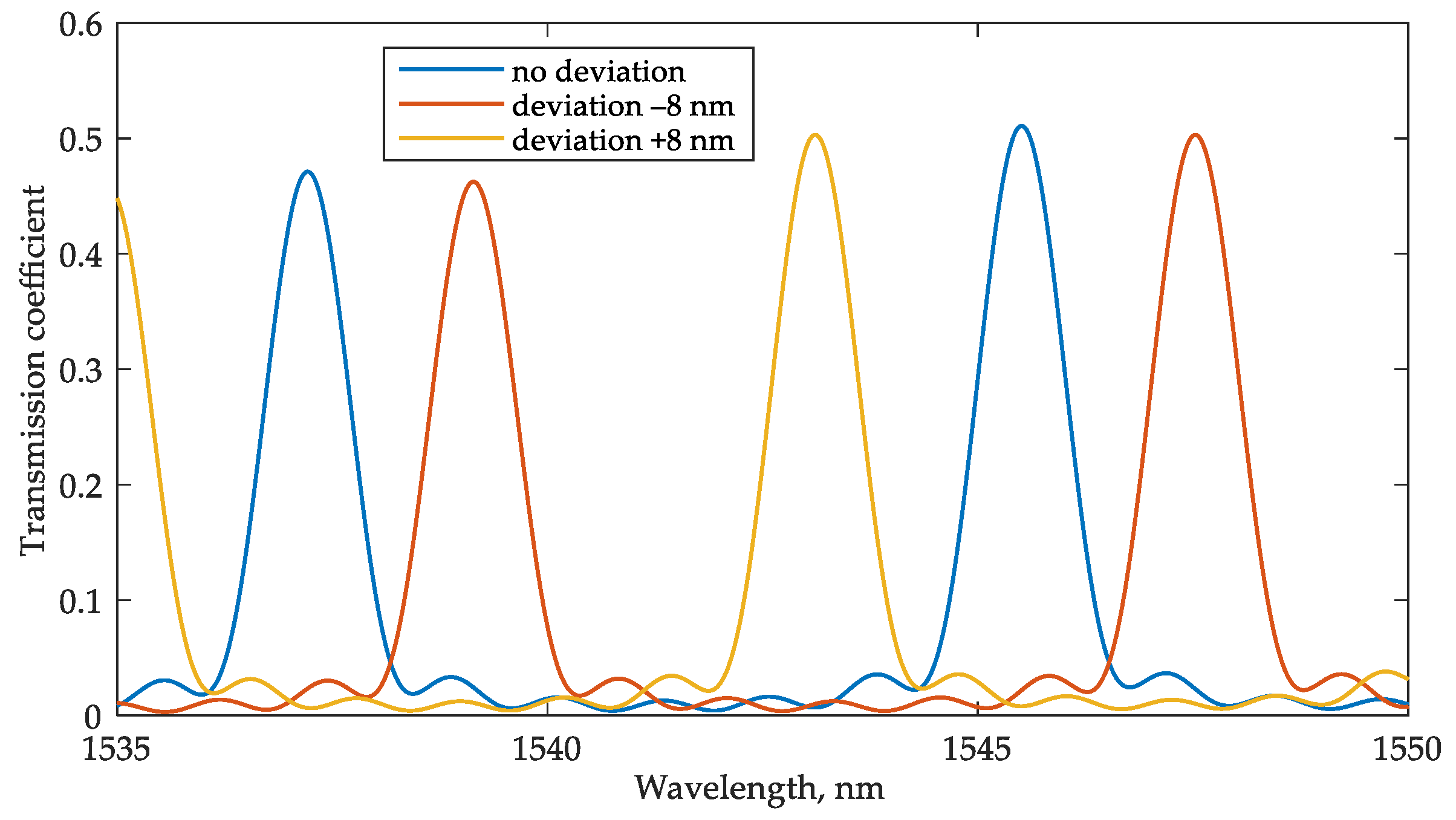
| Name | Value |
|---|---|
| Outer cladding diameter | 150 µm |
| Inner core diameter | 50 µm |
| Grating period | 0.5 µm |
| Number of periods | 20,000 |
| Effective refractive index | 1.5 |
| Periodic variation in the refractive index of the core | 10−3 |
| Material | SiO2 |
| Name | Value |
|---|---|
| Outer cladding diameter | 150 µm |
| Inner core diameter | 50 µm |
| Grating period | 0.51 µm |
| Phase-shifted aria | 0.51 µm |
| Number of periods | 4000 |
| Effective refractive index | 1.5 |
| Periodic variation in the refractive index of the core | 10−3 |
| Material | SiO2 |
Publisher’s Note: MDPI stays neutral with regard to jurisdictional claims in published maps and institutional affiliations. |
© 2022 by the authors. Licensee MDPI, Basel, Switzerland. This article is an open access article distributed under the terms and conditions of the Creative Commons Attribution (CC BY) license (https://creativecommons.org/licenses/by/4.0/).
Share and Cite
Voronkov, G.; Zakoyan, A.; Ivanov, V.; Iraev, D.; Stepanov, I.; Yuldashev, R.; Grakhova, E.; Lyubopytov, V.; Morozov, O.; Kutluyarov, R. Design and Modeling of a Fully Integrated Microring-Based Photonic Sensing System for Liquid Refractometry. Sensors 2022, 22, 9553. https://doi.org/10.3390/s22239553
Voronkov G, Zakoyan A, Ivanov V, Iraev D, Stepanov I, Yuldashev R, Grakhova E, Lyubopytov V, Morozov O, Kutluyarov R. Design and Modeling of a Fully Integrated Microring-Based Photonic Sensing System for Liquid Refractometry. Sensors. 2022; 22(23):9553. https://doi.org/10.3390/s22239553
Chicago/Turabian StyleVoronkov, Grigory, Aida Zakoyan, Vladislav Ivanov, Dmitry Iraev, Ivan Stepanov, Roman Yuldashev, Elizaveta Grakhova, Vladimir Lyubopytov, Oleg Morozov, and Ruslan Kutluyarov. 2022. "Design and Modeling of a Fully Integrated Microring-Based Photonic Sensing System for Liquid Refractometry" Sensors 22, no. 23: 9553. https://doi.org/10.3390/s22239553
APA StyleVoronkov, G., Zakoyan, A., Ivanov, V., Iraev, D., Stepanov, I., Yuldashev, R., Grakhova, E., Lyubopytov, V., Morozov, O., & Kutluyarov, R. (2022). Design and Modeling of a Fully Integrated Microring-Based Photonic Sensing System for Liquid Refractometry. Sensors, 22(23), 9553. https://doi.org/10.3390/s22239553







